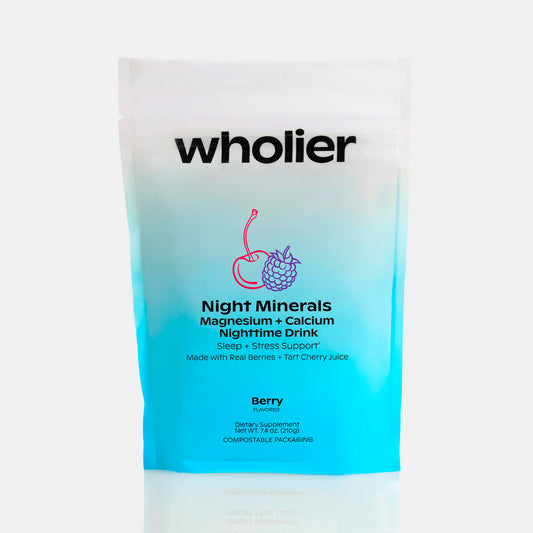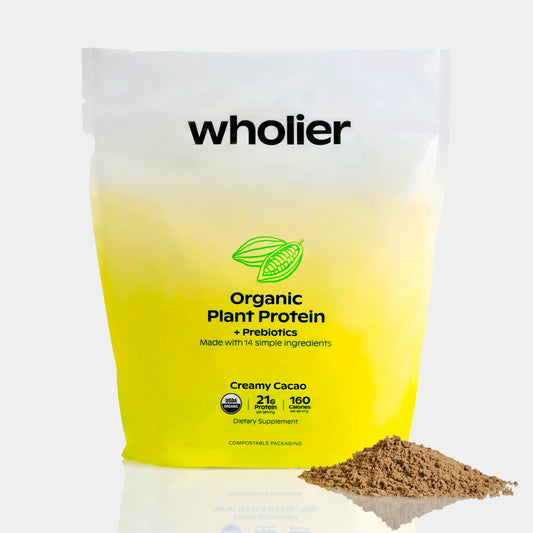
Nutrient Depletion in Our Soil: What Does It Mean Your Health?
You might have noticed that the tomatoes in your salad don't taste quite as good as they used to, or that the spinach in your smoothie isn't as vibrant as it once was.(1) There's a reason for this: the nutrient content of our soil is decreasing, which means the fruits and vegetables we eat are also becoming less nutritious. In this article, we'll explore the reasons behind nutrient depletion in our soil, what it means for American health, and what you can do to ensure you're getting the high-quality nutrients you need from your diet.
Why Are Nutrient Levels Decreasing in Our Soil?
The declining nutrient content of our soil can be attributed to several factors, including soil erosion, intensive farming practices, and overuse of synthetic fertilizers.(3)(4) Soil erosion occurs when soil is removed from the land due to wind, water, or other forces, taking with it vital nutrients.(5) Intensive farming practices, such as monoculture and over-cropping, can deplete the soil of nutrients as the same plants are grown repeatedly in the same area, without giving the soil time to recover.(6) Finally, the overuse of synthetic fertilizers can lead to an imbalance in soil nutrients, which can ultimately result in nutrient depletion.(7)
Which Nutrients Are Most Affected?
Research has shown that several key nutrients have been measured to be lower in our foods due to soil nutrient depletion. These include essential minerals such as calcium, magnesium, and potassium, as well as vitamins like vitamin C and vitamin A(8). A study published in the Journal of the American College of Nutrition found that nutrient levels in 43 different fruits and vegetables had declined significantly between 1950 and 1999.(9) This decrease in nutrient content can have significant implications for our health, as these nutrients play crucial roles in our body's functioning.
What Does This Mean for Our Health and Supplementation Needs?
The decline in nutrient content of our fruits and vegetables means that we may not be getting the essential vitamins and minerals we need to maintain optimal health. This can lead to various health issues, such as weakened immune systems, increased risk of chronic diseases, and impaired cognitive function.(10)(11) As a result, many people are turning to supplementation to ensure they're getting the nutrients they need. However, it's important to choose high-quality supplements and consult with a healthcare professional to determine the appropriate dosage for your specific needs.(12)
How Can We Ensure We're Getting High-Quality Fruits and Vegetables?
To ensure you're getting the most nutritious fruits and vegetables, consider the following tips:
Buy organic: Organic produce is grown without synthetic fertilizers and pesticides, which can contribute to soil nutrient depletion.(13) By choosing organic fruits and vegetables, you're not only supporting more sustainable farming practices but also getting more nutrient-dense produce.(14)
Shop local: Locally grown produce tends to be fresher, as it has not traveled long distances before reaching your plate.(15) This means that local fruits and vegetables are more likely to retain their nutrient content, as nutrients can be lost during transportation and storage.(16)
Grow your own: Growing your own fruits and vegetables allows you to control the quality of the soil and the nutrients that go into it.(17) By using organic methods and practicing crop rotation, you can help maintain and even improve the nutrient content of your homegrown produce.(18)
Which Supplements Should We Consider Taking?
If you're concerned about getting enough nutrients from your diet due to soil nutrient depletion, consider adding the following supplements to your routine:
Multivitamins: A high-quality multivitamin can help fill in the gaps in your diet, providing essential vitamins and minerals that may be lacking in your food.(19) Look for a multivitamin that contains a broad range of nutrients and is tailored to your age, sex, and specific health needs.(20)
Omega-3 fatty acids: Omega-3s are essential for maintaining heart and brain health, and they're often lacking in the modern diet.(21) Consider taking a fish oil or algae-based supplement to ensure you're getting enough of these vital fatty acids.(22)
Vitamin D: Vitamin D plays a crucial role in bone health, immune function, and mood regulation.(23) With many people spending less time outdoors and soil depletion affecting the vitamin D content of our food, supplementation can be an effective way to maintain adequate levels(24).
Probiotics: Maintaining a healthy gut microbiome is important for overall health, and probiotics can help support this balance.(25) Look for a probiotic supplement with a diverse range of strains and a high colony-forming unit (CFU) count to ensure maximum effectiveness.(26)
Nutrient depletion in our soil is a serious issue that has far-reaching implications for our health and the quality of the fruits and vegetables we eat. By understanding the causes of nutrient depletion and making informed choices about our food and supplementation, we can help ensure we're getting the essential nutrients we need to thrive.
Sources:
(1) Well+Good, "Why Your Produce Might Be Less Nutritious Than It Used to Be," https://www.wellandgood.com/soil-depletion-nutrient-density/.
(2) Davis, D.R., et al., "Changes in USDA Food Composition Data for 43 Garden Crops, 1950 to 1999," Journal of the American College of Nutrition 23, no. 6 (2004): 669-682.
(3) Lal, R., "Soil Erosion and the Global Carbon Budget," Environment International 29, no. 4 (2003): 437-450.
(4) Pimentel, D., et al., "Environmental and Economic Costs of Soil Erosion and Conservation Benefits," Science 267, no. 5201 (1995): 1117-1123.
(5) Montgomery, D.R., "Soil Erosion and Agricultural Sustainability," Proceedings of the National Academy of Sciences 104, no. 33 (2007): 13268-13272.
(6) Tilman, D., et al., "Agricultural Sustainability and Intensive Production Practices," Nature 418, no. 6898 (2002): 671-677.
(7) Stoorvogel, J.J., et al., "Managing Soil Fertility in the Tropics: A Resource Guide for Participatory Learning and Action Research," International Institute for Environment and Development (1998).
(8) Thomas, D., "A Study on the Mineral Depletion of the Foods Available to Us as a Nation over the Period 1940 to 1991," Nutrition and Health 17, no. 2 (2003): 85-115.
(9) Davis, D.R., et al., "Changes in USDA Food Composition Data for 43 Garden Crops, 1950 to 1999," Journal of the American College of Nutrition 23, no. 6 (2004): 669-682
(10) Tucker, K.L., "Nutrient Intakes, Nutrient Status, and Cognitive Function with Aging," Annals of the New York Academy of Sciences 1367, no. 1 (2016): 38-49.
(11) Chandra, R.K., "Nutrition and the Immune System: An Introduction," The American Journal of Clinical Nutrition 66, no. 2 (1997): 460S-463S.
(12) National Institutes of Health, "Dietary Supplements: What You Need to Know," https://ods.od.nih.gov/HealthInformation/DS_WhatYouNeedToKnow.aspx.
(13) Barański, M., et al., "Higher Antioxidant and Lower Cadmium Concentrations and Lower Incidence of Pesticide Residues in Organically Grown Crops: A Systematic Literature Review and Meta-Analyses," British Journal of Nutrition 112, no. 5 (2014): 794-811.
(14) Curl, C.L., et al., "Organophosphorus Pesticide Exposure of Urban and Suburban Preschool Children with Organic and Conventional Diets," Environmental Health Perspectives 111, no. 3 (2003): 377-382.
(15) Pirog, R., et al., "Food, Fuel, and Freeways: An Iowa Perspective on How Far Food Travels, Fuel Usage, and Greenhouse Gas Emissions," Leopold Center for Sustainable Agriculture (2001).
(16) Kader, A.A., "Increasing Food Availability by Reducing Postharvest Losses of Fresh Produce," Acta Horticulturae 682 (2005): 2169-2176.
(17) Pretty, J., et al., "Resource-Conserving Agriculture Increases Yields in Developing Countries," Environmental Science & Technology 40, no. 4 (2006): 1114-1119.
(18) iebman, M., and E.R. Gallandt, "Many Little Hammers: Ecological Management of Crop-Weed Interactions," in Ecology in Agriculture, ed. L.E. Jackson (San Diego: Academic Press, 1997), 291-343.
(19) Bailey, R.L., et al., "Examining the Relationship between Multivitamin Use and Nutrient Intakes and Adequacies in the United States," The American Journal of Clinical Nutrition 104, no. 6 (2016): 1598-1607.
(20) Comerford, K.B., "Recent Developments in Multivitamin/Mineral Research," Advances in Nutrition 8, no. 6 (2017): 839-850.
(21) Swanson, D., et al., "Omega-3 Fatty Acids EPA and DHA: Health Benefits Throughout Life," Advances in Nutrition 3, no. 1 (2012): 1-7.
(22) Lane, K., et al., "Bioavailability and Potential Uses of Vegetarian Sources of Omega-3 Fatty Acids: A Review of the Literature," Critical Reviews in Food Science and Nutrition 54, no. 5 (2014): 572-579.
(23) Holick, M.F., "Vitamin D Deficiency," The New England Journal of Medicine 357, no. 3 (2007): 266-281.
(24) Wacker, M., and M.F. Holick, "Vitamin D - Effects on Skeletal and Extraskeletal Health and the Need for Supplementation," Nutrients 5, no. 1 (2013): 111-148.
(25) Sanders, M.E., et al., "Probiotics and Prebiotics: Prospects for Public Health and Nutritional Recommendations," Annals of the New York Academy of Sciences 1309, no. 1 (2014): 19-29.
(26) Hill, C., et al., "Expert Consensus Document: The International Scientific Association for Probiotics and Prebiotics Consensus Statement on the Scope and Appropriate Use of the Term Probiotic," Nature Reviews Gastroenterology & Hepatology 11, no. 8 (2014): 506-514.






